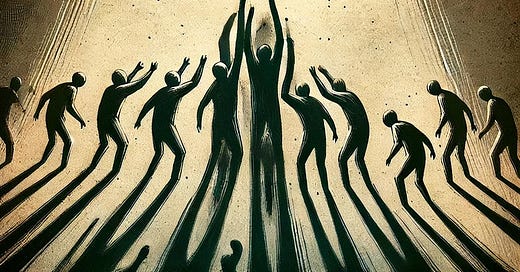Allyship or Power Play? Unpacking the Legacy of “Power Over” in Whiteness
Exploring the Roots of True Allyship and the Unseen Dynamics Shaping Whiteness
Introduction:
Take a deep breath. This article is going to ask you to reflect, to move past the surface and dive deep. It may stir up thoughts, memories, and even discomfort. So I encourage you to prepare: grab a journal, pour yourself some water, and give yourself permission to move your body as you read. Somatic work—grounding ourselves through physical awareness—will help you stay present with the truths we’re about to explore.
Now, let’s begin.
If we take an honest look at allyship today, we see a gap—a gap between the intention to support and the impact of historical systems embedded within white communities. Allyship often falters, especially when seen from the perspective of the global majority, because it’s missing a foundation of genuine self-examination. Many white communities haven’t yet confronted the dynamics that uphold their internal power structures—structures rooted in centuries of hierarchy, dominance, and self-interest.
The Legacy of “Power Over” in White Identity
White communities in the U.S. often struggle to engage in true camaraderie. This challenge is rooted in a historical legacy that predates the formation of race and the colonial project. The concept of power over has deep roots, stretching back to feudalism in Europe, when social structures revolved around rigid hierarchies. When we trace these systems back, we see that the dynamics were set in motion long before race became the primary organizing factor in America.
Under feudalism, peasants were systematically controlled, marked as “lesser,” and seen as expendable by their own kin. These early power dynamics primed European societies to accept hierarchy as normal. As Christianity spread, the structure of “power over” intensified, introducing religious conformity and the erasure of ancestral practices. Christianity reinforced dominance, transforming cultural identity into something monolithic and easily controlled.
With the arrival of capitalism, this system shifted yet again, replacing the feudal lord’s power with that of economic dominance. White communities, already shaped by these hierarchical values, adapted to a system that rewarded accumulation and control over community and solidarity. As European colonizers arrived in America, they brought with them a fractured identity, unified by only one thing: whiteness. This fragile identity, designed to uphold power over others, found its strongest expression in racial superiority.
The Blueprint of “Power Over”: Feudalism, Christianization, and the Birth of Capitalism
Europe’s feudal system set the stage for a worldview centered on domination and hierarchy, marking the poor and common as expendable. This system taught Europeans to see control—not community—as the foundation of survival, a mindset reinforced by Christianization, which erased ancestral practices and forced cultural conformity. These patterns of control later crossed the Atlantic with colonization, where race became the mechanism of power.
Yet we don’t have to look outside Europe to see this legacy in action. Ireland, which remains partially colonized to this day, offers a stark example of how these dynamics persist. As English rule imposed centuries of religious and economic control over the Irish people, Irish culture, language, and practices were systematically suppressed. Despite being white-bodied, Irish communities were subject to the same “power over” tactics of dominance and cultural erasure used against colonized people of color. This suppression continues, reflecting feudalism’s holdover: a pattern where even white-bodied people are oppressed to maintain hierarchical power.
The colonization of Ireland reveals how the same systems of Christianization and capitalism that divided white communities still leave them fractured today. The Irish experience shows that “power over” within whiteness isn’t new—it’s an enduring structure that continues to divide and control. Without cultural grounding or solidarity, many white communities find themselves connected only by the pursuit of power, leaving a fractured legacy that emphasizes hierarchy over shared humanity.
Voting Patterns: Choosing Self over Community
This legacy of “power over” influences white communities even today, particularly in how they engage with politics and voting. A common misconception is that white women vote against their best interests, particularly when aligning with patriarchal and conservative values. But the reality is more complex. White women often vote not against themselves but for their own preservation. Their political choices are a calculated way to navigate patriarchy and capitalism—a means of aligning with the power structures that provide them security, even if it costs others.




